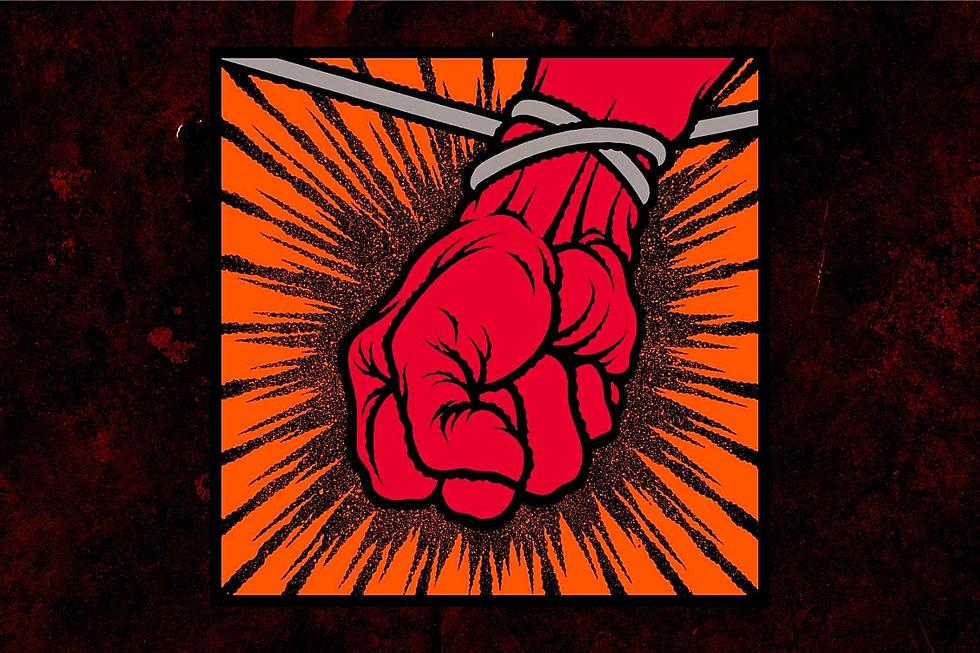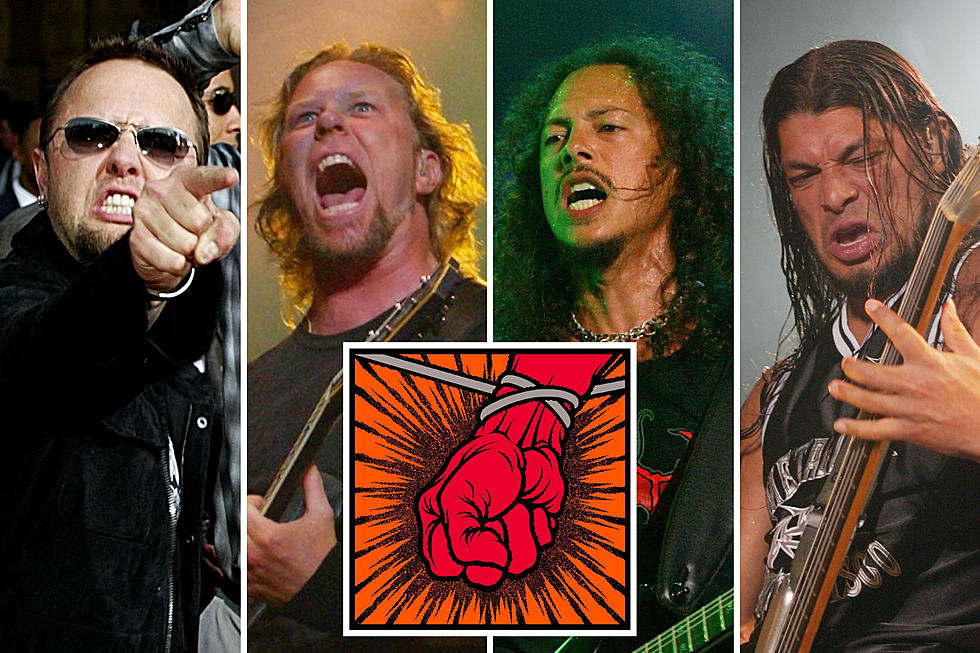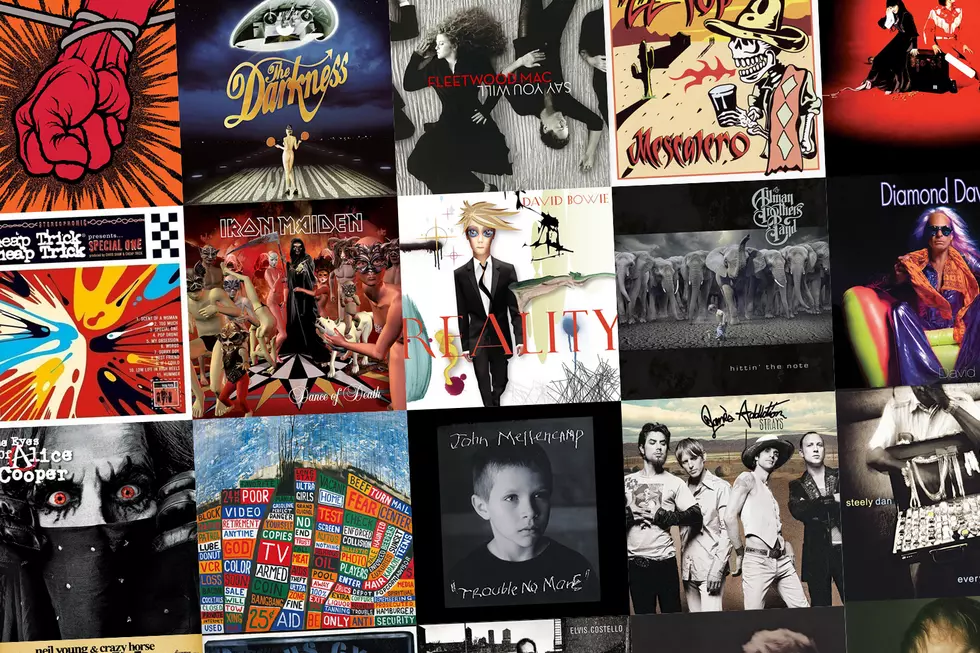
Metallica, ‘St. Anger’ – Album Overview
By the new millennium, Metallica had released seven studio albums, two official live albums and one album chock full of covers and B-sides. Each of these releases reached multiplatinum-selling status, further cementing Metallica in the history books of rock and roll. As the 2000s began to take shape, though, that success looked like it might have an end date in sight.
With Lars Ulrich alienating fans by taking a very public stance against the online music sharing giant known as Napster, James Hetfield spending nearly a year in a rehabilitation center for alcoholism and Jason Newsted being asked to leave Metallica, nobody knew what was in store for the legendary band.
The Beginnings of St. Anger
Recording for the album that would eventually turn into St. Anger, Metallica's eighth studio album, began in January 2001. The band rented an old army barracks on the Presidio of San Francisco and turned them into a recording studio. The writing process for this record was different than any other before; instead of Hetfield coming into the studio with some riffs and lyrics already ironed out, he sat in a room with Ulrich, Kirk Hammett and record producer and fill-in bassist Bob Rock and simply brainstormed ideas for the album.
"This time we all got into a room and just started playing and that's how we wrote songs," Hammett said. Rock added to that sentiment, "It should sound like a band getting together in a garage for the first time, only the band is Metallica."
This might not seem as extreme as it sounds, but prior to entering the Presidio, the relationships between each band member were at an all-time low. Sitting in a room and writing songs in a very vulnerable state created too much tension for Metallica, so much so that they decided to hire a therapist to sit in on the recording process to help them deal with whatever it was that had come between them.
Trouble at the Presidio
About seven months into the recording of this record, Hetfield abruptly entered rehab for his own alcoholism. Other than a few conversations with Hammett, the frontman for Metallica stayed secluded and away from anything and everything that reminded him of the band and his past life of partying.
In April 2002, nearly a year after entering rehab, he returned to the studio and the process began all over again.
However, it was at this time that the guys decided to pack up and find a new place to continue the album, the studio known as HQ in San Rafael. Recording picked up, songs were developed, relationships began to heal and a new bassist was hired (although, Robert Trujillo did not contribute to the album). When St. Anger was completed, the band knew they had something different in their hands.
Watch the Official Music Video For Metallica's "St. Anger"
"We're on the same stream of consciousness, we're all working on the same creative wavelength," Hammett said of the album and recording process. Fans and critics were not as positive about the album when it hit storeshelves on June 5, 2003. The different snare drum sound that Ulrich created and the lack of guitar solos all stood out as reasons for fans and the press to rip apart the record. Regardless of the negative reaction, St. Anger debuted at No. 1 in 30 countries in its first week of release. To date, the record has sold over 6 million copies worldwide.

An understanding of the creative process that went into this album helps convey a better understanding of why it sounds the way it does. There is a level of anger and rawness that was never found on any other Metallica record, but there was also a realm of positive energy that seemed inconsistent with that anger. As Hetfield says, "It's angry in a healthy way."
The lyrics, dirty guitar riffs and ringing of Ulrich's drums all come together to create an album like no other. Fans who want to fully grasp what St. Anger is need to, without a doubt, watch the 2004 documentary, Some Kind of Monster.
St. Anger Track by Track
"Frantic"
For the first minute and five seconds, before Hetfield's vocals explode through the speakers, Metallica lay the foundation for the album with the incredibly raw intensity of "Frantic." As the song builds and Hetfield gets into the meticulous lyrics of "Frantic, tick, tick, tick, tick, tick, tock," it's obvious that his anger and frustration with numerous things in his life are pouring out into his music. When the band was debating an album title, Ulrich was very vocal about his desire to name it Frantic, although he was obviously overturned. "Frantic" was the second single released from St. Anger.
"St. Anger"
The first single off of the album of the same name, "St. Anger" won Best Metal Performance at the 46th Grammy Awards. The anger-fueled song gives a shout out to the classic tracks "Damage Inc." and "Hit the Lights" with the lyrics, "Fuck it all and fuckin' no regrets, I hit the lights on these dark sets." It only makes sense that a song as intense as this one would have a music video of equal intensity. To get to that level, the band decided to film the video at San Quentin State Prison in California.
"Some Kind of Monster"
The band "built a Frankenstein" monster when they wrote this track, one of the first created through the new collaborative brainstorming process. Nominated for a Grammy Award for Best Hard Rock Performance in 2005, "Some Kind of Monster" was developed during the Presidio sessions, before Hetfield left for rehab. The beginning of the tune is very symbolic of the overall sound of the album as a whole, with the raw guitar riff rattling the snare of Ulrich's drum.
"Dirty Window"
There's no doubt this song comes from Hetfield's continued struggle of accepting the fact that he isn't always in control. When Hetfield goes into the rhyming lyrics of "Projector, protector, rejector, infector," it's hard not to be reminded of the same style of lyrics from 1988's "Blackened" that included "Opposition, contradiction, premonition." Coming in at five minutes and 25 seconds in length, it is one of the shorter tracks on St. Anger. It was first played in the United States on Dec. 31, 2003, at The Joint in Las Vegas.
"Invisible Kid"
The first minute of the track is ruthless in its power, and for the next seven and a half minutes the intensity never lets up. If it hasn't been obvious up to this point, the fifth tune on St. Anger sets the record straight: this album deals with anger, depression, temptation, frustration and every other intense emotion the members of Metallica dealt with in the early 2000s. Quite poetically, Hetfield sings "Invisible kid, got a place of his own, where he'll never be known, inward he's grown," and uses this song as another outlet for the inner demons he and the rest of the band faced during the writing and recording of this record.
"My World"
Forty seconds into this song, Ulrich's signature St. Anger drum sound takes center stage. The ringing of the snare overpowers the energy of the rest of the band, until Hetfield explodes with the opening lyrics, "The motherfuckers got in my head, trying to make me someone else instead." Utilizing multiple vocal tracks and a haunting bridge where Hetfield whispers for a few seconds followed by a screaming response, "My World" is full of non-stop energy that sounds like Metallica rolled up months and months of therapy and put it into this one song.
"Shoot Me Again"
An onslaught of heavy guitar riffs and crushing drum beats, "Shoot Me Again" solidifies the intensity of the album. At one time during the filming of the documentary, Hetfield said that this album is "aggressive and fucked up with positive energy." "Shoot Me Again" personifies that description. It began to take form in the HQ studio around day 525 of recording.
"Sweet Amber"
Opening with an almost bluesy guitar riff, it doesn't take long for Metallica to turn that riff into an explosive, dynamic tune. The first line, "Wash your back so you won't stab mine," was inspired by a promotion that Metallica's management agreed to for a fleet of rock radio stations. While Metallica felt the promotion was cheesy and went against everything they stood for, they were told if they didn't do it they would essentially be blacklisted by those radio stations. After hearing that, Hetfield and the band came up with the opening line of the song.
"The Unnamed Feeling"
The third single from St. Anger, this song explores the feeling that a person feels as they stand on the edge of losing all control. At the time of writing and recording the album, this feeling was definitely present for all of the members of Metallica. During their set at the Cow Palace in San Francisco on March 8, 2004, the band played "The Unnamed Feeling" for the first time to a live audience in the United States.
"Purify"
With a beat that is hard to keep track of, this is one of the most crushing tunes on the album. Trying to move forward from their own personal issues and past lives of heavy partying, "Purify" is no doubt a meaningful, personal release the band, especially Hetfield. Considering his stint in rehab that postponed the recording of the album—not to mention the constant struggle for control between him and Ulrich—lyrics like "Purify, can't you help me, purify, won't you help me, purify you and I" help show how much the band grew during St. Anger.
"All Within My Hands"
"All Within My Hands" is the longest track on the album and one of the most emotional. The band seems to be at their most vulnerable during this song, with Hetfield singing "Love is control, I'll die if I let go." The first time this song was played live in any form was on Oct. 27, 2007—more than four years after St. Anger was released—at the Bridge School Benefit concert in Mountain View, California. The band performed the album closer acoustically.
Watch Metallica Perform "Dirty Window" Live in San Francisco
10 Things We Learned About Metallica from 'Some Kind of Monster'
Here Are Some of Our Favorite Metallica T-Shirts
More From Ultimate Metallica









